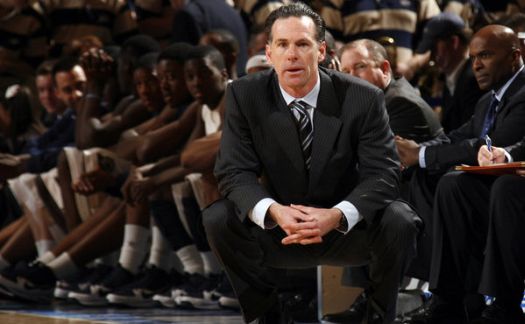What to Make of Pittsburgh Through Another Weak Non-Conference Schedule
Posted by Jason Priziborowski on December 22nd, 2013Pittsburgh is having another solid season, currently sitting at 11-1 after torching visiting Cal Poly by 17 points over the weekend. Here’s the key question, though: Does this record represent a run at an elite season for the Panthers or is this just another instance of strategic scheduling? Many coaches schedule their non-conference slates to challenge and help prepare their teams for the rigors of conference play; while others schedule to win a bunch of games. John Calipari, Roy Williams, and Tom Izzo tend to fall into the latter camp, whereas Jamie Dixon, Jim Boeheim and many others are regularly accused of falling into the former camp.

Jamie Dixon has been piling up non-conference wins, but does it prepare his team for later in the season?
For the past three years, Dixon has clearly followed the philosophy of scheduling to win. This season Pittsburgh is 11-1 in non-conference play with one more game against Albany to go before ACC play begins. This year the Panthers have only played four teams in the RPI Top 100 (Stanford at #46, Cincinnati at #67, Penn State at #73, and Fresno State at #92), beating all but the Bearcats. Last season they also finished non-conference play 12-1, having played only two teams in the RPI top 100 (Michigan at #17 and Detroit at #64), splitting those games. In 2011-12, Pittsburgh finished non-conference play at 11-2, playing five teams in the RPI top 100 (Long Beach State at #36, La Salle at #83, Tennessee at #86, Wagner at #92, and Penn at #98), losing to both Long Beach State and Wagner.
The problem for Pittsburgh is that it plays in the tough-as-nails ACC, so if non-conference play doesn’t prepare the Panthers for the difficulties of league play, it’s tough to just flip the switch on come January. It’s understandable that coaches don’t want to schedule such a difficult non-conference schedule that their teams are burned out and lacking confidence heading into the conference season, but there needs to be enough competition so that the team also improves from early November to late December. Last year Pitt finished the non-conference season at 12-1, went 12-6 in the Big East, and then lost its first game of the Big East Tournament before doing likewise in the NCAA Tournament. The year before that, Pitt finished non-conference play at 11-2 before falling apart in the Big East with a 5-13 record and not making the NCAAs at all.
With such a weak schedule to date, Pitt has shown flashes of dominance, but the Panthers had a hard time putting Cal Poly away on Saturday and looked absolutely dreadful in last week’s 44-43 Jimmy V loss versus Cincinnati. Such inconsistency, especially on the offensive end, is unlikely to work against the likes of Duke, North Carolina, and Syracuse this season. It might not even work against several others in the ACC that have played a tougher schedule. The other issue is that, as good as Lamar Patterson has been, he is a high-usage guy (26.3% shots) who holds eight of the top 11 scoring performances for the team this year. Having to count on one major offensive player like that is a dangerous situation when entering ACC play, as teams will utilize numerous schemes and defenders to shut him down.
Pittsburgh’s schedule thus far ranks among the worst 50 or so teams in the country, and its lesser talented opponents have not been capable of exposing the team’s holes, but ACC teams are too sophisticated to overlook them. Although Pittsburgh’s 11-1 record is an indication of a winning attitude, the truer indication of how good Pitt will be this year won’t come until January 4 against NC State and beyond. Until then, it’s mostly guesswork.









































